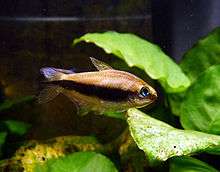Nematobrycon palmeri
Nematobrycon palmeri, commonly known as the emperor tetra, is a species of characid fish found in the Atrato and San Juan river basins in western Colombia. It was first imported in the aquarium trade to the United States in 1960 and has since become well established.
| Nematobrycon palmeri | |
|---|---|
 | |
| A female | |
| Scientific classification | |
| Kingdom: | Animalia |
| Phylum: | Chordata |
| Class: | Actinopterygii |
| Order: | Characiformes |
| Family: | Characidae |
| Genus: | Nematobrycon |
| Species: | N. palmeri |
| Binomial name | |
| Nematobrycon palmeri C. H. Eigenmann, 1911 | |
Description
The purple hue of these tetras will be more apparent in an aquarium with floating plants on the surface and relatively subdued lighting. If the aquarium is too bright, the yellow coloration will dominate. The body is long, slim, and flattened to about 3 inches at maturity. Looking from the eye to the tail area, you will find a black line placed within a blue stripe. The sickled shaped dorsal fin, along with the pectoral fin and anal fins are yellow. The male is larger than the female and his anal fins are longer. The male caudal is more pointed than the female.
Emperor tetras are highly sexually dimorphic and thus males and females are quite easily distinguished from each other. There are several ways to tell a male and female apart, the most reliable method is to observe the eye color. Males will have metallic blue eyes while females possess metallic green eyes. Also, the male has a three pronged tail with the medial black stripe usually extending beyond the rest of the tail, while in the females this median black stripe will typically only reach as far as the clear part of the tail. However, this is not always the best indicator as the third prong in males can sometimes be nipped off in competitions with tank mates and more dominant females may sometimes grow this extension of the tail as well.
Foods and feeding
The emperor tetra is an omnivore, eating both animal and vegetable food. Any good flake or pelleted fish food is a good basis for its diet. It will benefit from live food like daphnia and mosquito larvae as well as frozen fish food including frozen bloodworms.
Breeding
In a large well planted aquarium a single pair of emperor tetras will often breed without any extra stimulation. If there are no other fish, some of the babies may survive especially if the parents are well fed. In a large, well planted aquarium the babies will find some useful natural food in the form of protozoa, algae, etc. Screened daphnia will provide them with more nourishment as they grow, and dry fry food can be used.
In the aquarium
The emperor tetra is a placid aquarium fish and will be disturbed by more boisterous species. It grows to 4.2 cm.[1] It prefers a pH of 6.5, a hardness of 3-6 dKH and a temperature of 23–27 °C. It does not school as readily as most tetras, and a pair appears happier than with most tetras. However, with the addition of fresh cool water, a large group of emperors will school across an aquarium, sometimes for several minutes.
Gallery
References
- "Emperor Tetra". Fishlore.
- Encyclopaedia of Aquarium and Pond Fish (2005) (David Alderton)
- Emperor tetra fact sheet: http://www.bettatrading.com.au/Emperor-Tetra-Fact-Sheet.php
- Aquarium Fishes and Plants: text By K. Rataj and R. Zukal, Illustrations By J. Maly', Spring Books, 1972
| Wikimedia Commons has media related to Nematobrycon palmeri. |

